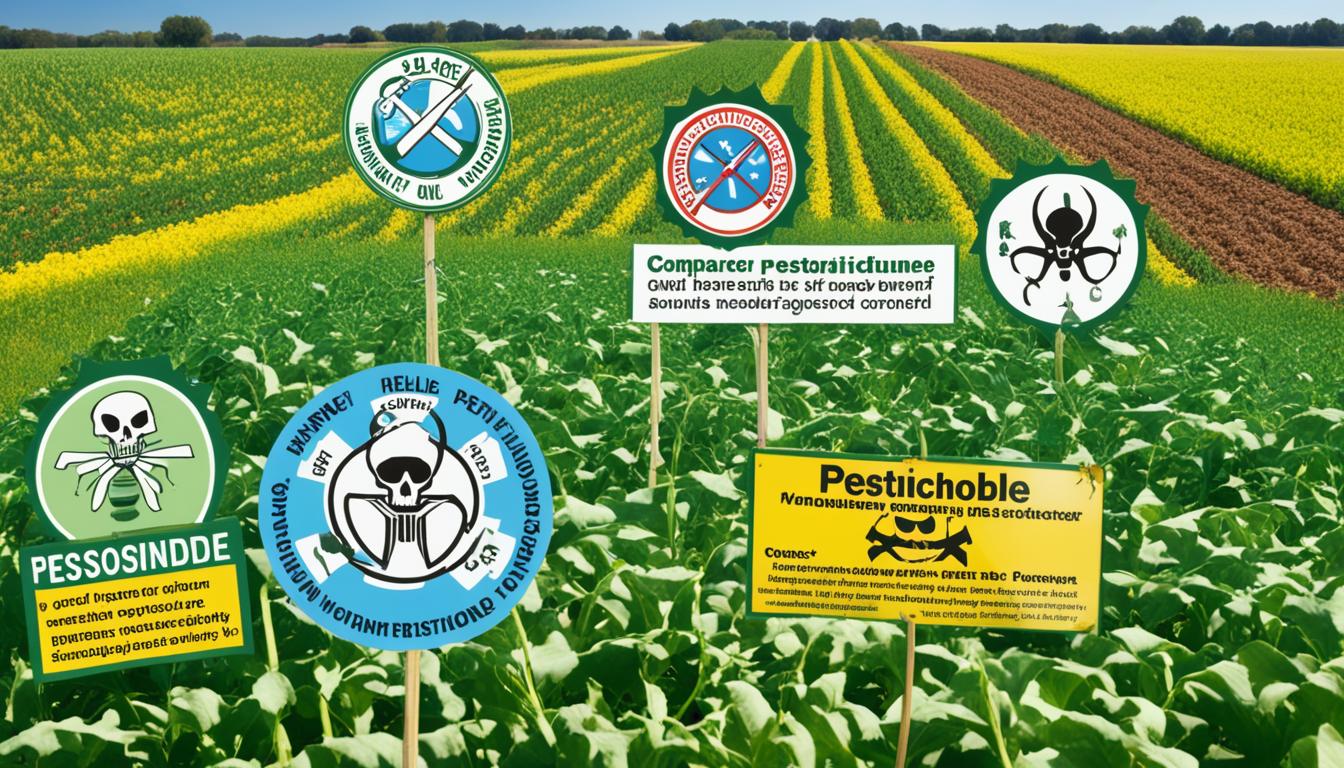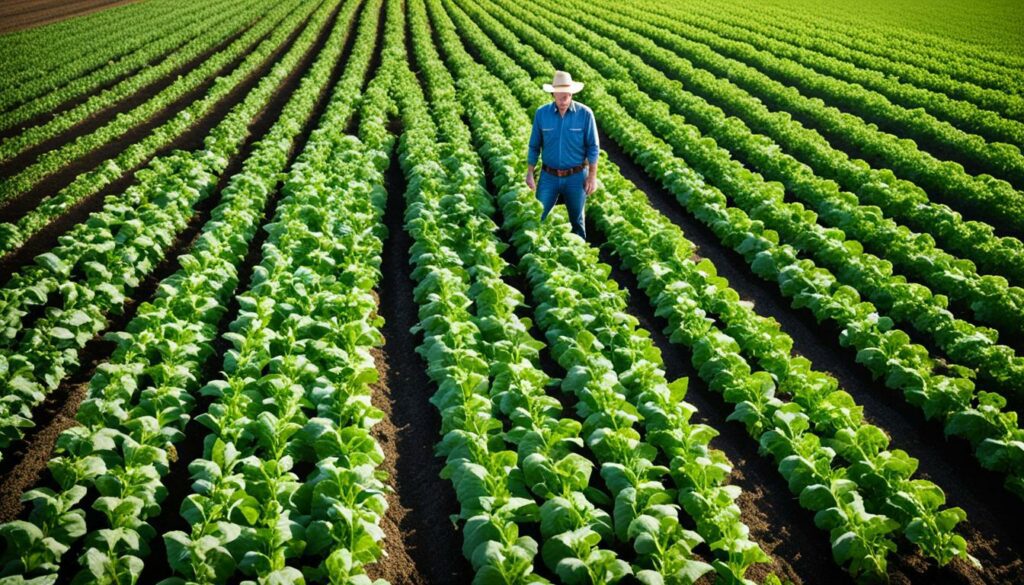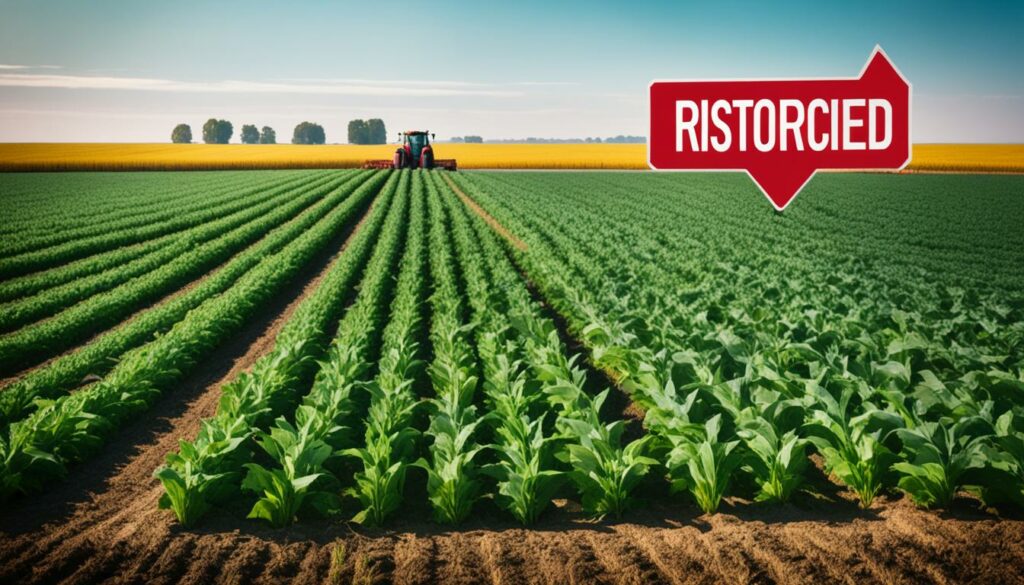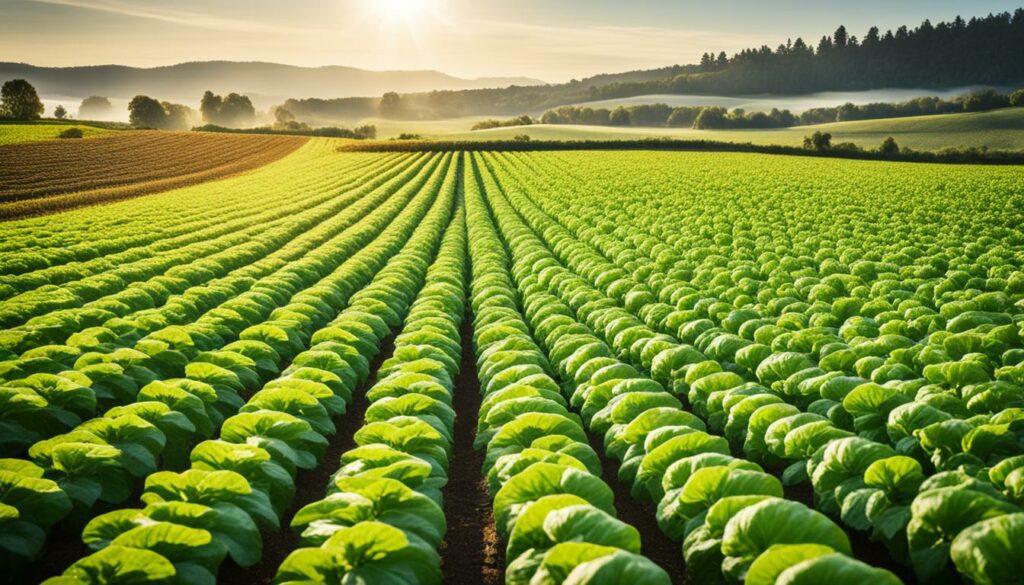Menu

More than 30 states, like Georgia, Kentucky, and Texas, now have tough rules on how close pesticides can be sprayed near schools. There are over 4,028 elementary schools only 200 feet away from crop fields. This makes strong pesticide restrictions crucial for public health, the environment, and long-term farming.
As someone who works in farming, I see how these rules are getting more complicated but are vital. The USDA OPMP is a key player in setting pest management and pesticide rules. They help protect growers’ needs, partner with the EPA for safe pesticide use, and push for proper pest control in the food industry. Knowing about these changes helps us all keep food safe and protects wildlife too.
The history of limiting pesticide use shows how rules have changed alongside science and what people want. This background is key to seeing why strict rules are crucial. They help keep food safe, protect nature, and aid farmers in fighting pests.
Use of pesticides in farming has changed a lot since the early 1900s. Back then, man-made pesticides started a farming revolution. But as we learnt more about their bad effects on the environment and health, rules got tighter.
One example is DDT, which was banned in the 1970s for harming wildlife and people. Since then, a more careful, worldwide approach to pesticides has been taken.
Strong pesticide regulations in farming are key for several big reasons. They shield us from dangerous chemicals in our food. Studies warn about these risks, showing why rules are needed.
They’re also good for our planet, by lessening harm to the soil, water, and wildlife. Moreover, they help farmers by ensuring they manage pests safely and protect their health and crops.
For instance, in Thailand, farming is big business. It adds a lot to the country’s money and is a top food exporter. With medium pesticide use per land area, Thailand faces the hard task of upholding safe farming pesticide guidelines. The change in how much pesticide they buy each year reflects the evolving rules. Plus, less cases of pesticide poisoning hint at the rules working.
The health codes for pesticide sickness point to a wide range of problems. By controlling some weed killers, Thailand managed to use less of them. This shows how rules change how pesticides are used.
These instances show us how crucial pesticide regulations in farming are. They protect us and nature while helping farmers do their jobs safely and with the future in mind.
Following pesticide rules is key in modern farming for legal and best practice reasons. The Environmental Protection Agency (EPA) is the main authority. They make sure using pesticides is safe and doesn’t harm people or the environment. Farmers need to know these rules to do well with their crops and follow the law.

The EPA looks at many things related to using pesticides. They check and make rules for new chemicals, decide how much residue is okay, and limit how they’re used. Every new pesticide has to pass strict safety checks. If a chemical is deemed too risky, like paraquat and glyphosate, the EPA will stop or limit its use.
These rules really affect how much and what quality of crops we get. Farmers have to fit these rules into their usual ways to keep their crops healthy. Sometimes, they need to change how they control pests to meet these rules. Changes in what countries like Thailand buy, with more fungicides and insecticides, show how farming changes globally. This is crucial for the health and market success of the crops.
The Food Quality Protection Act of 1996 (FQPA) changed how we look at pesticide safety in foods. Its goal is to keep consumers safe, especially infants and children. This law made sure pesticides in food met strict safety checks. It has since greatly improved these checks and how we use pesticides in farming.
One big goal of the FQPA was to check how safe pesticides really are. By its tenth year, the EPA had looked into almost all the pesticides it needed to. It had made over 9,600 safety decisions. Nearly all decisions on whether a pesticide could be used on food were also made by 2006. The EPA was busy making sure never-safe pesticides were stopped and changing others to be safer.
What happened next included many steps. The EPA used special tests to see if the ways we use pesticides around homes are safe. They looked at risks from touching, breathing, or eating pesticides. They also looked at the combined risk from different pesticides that affect the body in similar ways.
To make sure rules were followed, the EPA worked hard. They stopped the sale of over 4,000 different pesticides because they were not safe enough. This made sure businesses followed the new, safer rules. By 2008, they planned to finish checking a few more pesticides used outside of food.
The following table summarises some key statistical achievements under the FQPA:
| Metric | Outcome |
|---|---|
| Completed Tolerance Reassessments | 9,637 out of 9,721 |
| Revoked Tolerances | 3,200 |
| Modified Tolerances | 1,200 |
| Confirmed Safe Tolerances | 5,237 |
| Cancelled Pesticide Registrations | 4,400 out of 17,592 |
After the FQPA, the EPA carefully looked into hundreds of exemptions for pesticide ingredients. They looked at all kinds of information, even from international groups. This shows the EPA’s strong commitment to keeping people and nature safe from harmful pesticides.
The USDA’s Office of Pest Management Policy (OPMP) plays a key role. It shapes and carries out rules on pesticide use, dealing with important concerns of farmers. This office was set up in the late 90s because of the Food Quality Protection Act. Since then, it has been very important in making and overseeing pesticide rules.

The OPMP works closely with the Environmental Protection Agency (EPA). Their teamwork is crucial for checking new pesticide ingredients and making sure old ones are safe. By working together, they aim to set rules that are good for the economy and the environment. This helps farming be more sustainable.
The OPMP is big on talking with everyone involved, from the people who grow food to those who process it. This means they listen to different groups like farmers, researchers, and food processors. Everyone’s views are taken into account. This way, the farming community knows their concerns are being heard and dealt with.
Part of the OPMP’s work is helping organic farm operators with pest control. They also push for the use of pest management methods that are better for everyone. This includes using less harmful pesticides. The goal is to lower risks to the economy, the environment, and health through these methods.
The OPMP also teams up with the USDA’s Chief Scientist Office. They work on protecting important insects like bees. They push for better rules to help farmers growing hemp. This shows the OPMP really cares about the challenges farmers face with these rules and works hard to solve them.
The COVID-19 pandemic brought big problems for farming. There were changes in how pesticides were used and got. The way we protect crops also changed because of supply chain breaks. This made it hard to find or buy the pesticides farmers needed.
The pandemic quickly made global supply chains mess up. This stopped many pesticides from getting where they needed to be. China’s shutdowns hit the world hard because it’s a major PPP supplier. Plus, shipping across East Africa suddenly became very expensive, making pesticides less available there too.
Farmers couldn’t keep up with using pesticides on time. There were not enough workers, and they couldn’t find the right tools. This made it tough to control pests, which could mean losing more crops.
Thailand had its share of challenges, ranking high for pesticide use. In 2021, it imported big amounts of herbicides, fungicides, and insecticides. But, the pandemic made importing harder. Now, Thailand’s government wants to use less pesticides and use safer methods instead.
Pesticide poisoning in Thailand has been going down, which is good news. Better crop protection methods and rules might be helping. But, many cases of poisoning are still not reported properly. This is because of wrong diagnoses and problems with reporting the cases.
| Year | Pesticide Type | Quantity Imported (Metric Tons) |
|---|---|---|
| 2021 | Herbicides | 36,300.4 |
| 2021 | Fungicides | 12,513 |
| 2021 | Insecticides | 10,294.3 |
The pandemic has made us rethink how we use pesticides. We need to find better and safer ways to protect our crops. This means working to make sure we have enough food without harming the environment.
Integrated Pest Management (IPM) is vital for today’s sustainable farming. It uses various ways to handle pests without heavy use of chemicals. This way, it keeps us safe and the environment healthy. It also helps agriculture to stay strong over time.

The core of IPM is keeping an eye on pests and knowing them well. This lets farmers choose the best actions. They mainly focus on preventing, watching, and intervening to stop a pest problem.
Prevention is key, aiming to keep crops healthy without chemicals. This includes changing crops, using strong plant types, and smart planting dates. Watching means looking out for pests and their numbers. Then, farmers decide what to do next. This can include using natural enemies of pests and sometimes using chemicals.
IPM has many pluses. It cuts down on dangerous chemicals. This helps our health and our world. Also, it makes farming a friend to nature by supporting different plants and improving the land.
But there are bumps in the road when trying IPM. It asks for a lot of know-how and learning by farmers. There’s also more work in checking for pests and using different pest controls. Yet, in the long run, the benefits in saving money and the environment are worth it.
| Aspect | Conventional Pesticide Use | Integrated Pest Management |
|---|---|---|
| Chemical Use | High | Reduced |
| Environmental Impact | Significant | Minimal |
| Long-term Viability | Low | High |
| Implementation Cost | Moderate | High Initially |
| Knowledge Requirement | Basic | Advanced |
The world of farming is always changing, especially when it comes to using pesticides. Rules about which pesticides we can use are becoming stricter. Recent changes highlight pesticides like chlorpyrifos and dicamba. Farmers need to know these rules well to avoid getting into trouble. Let’s talk about what these new rules are.
Chlorpyrifos was once a go-to pesticide for fighting pests. But, it has come under the microscope for its health and environmental dangers. The use of chlorpyrifos has been tightly controlled since 1947. However, more serious measures were not taken until 1988 for harmful pesticides. Because of health fears, the EPA has now fully banned chlorpyrifos. Farmers must find other ways to protect their crops.
Dicamba also faces tougher rules because it can easily spread to other fields. To avoid harming neighbouring crops, dicamba’s use is now strictly monitored. The law requires detailed records from anyone who uses dicamba. These records should show what dicamba was used, how much, where, and when. Such carefulness is aimed at keeping other crops safe and protecting our plant life variety.
The ESA makes sure that using pesticides does not threaten any species close to extinction. The EPA, helped by the ESA, checks that pesticides like dicamba and chlorpyrifos are safe for the environment.
Dealing with pesticides goes beyond just using them right. Workplace safety is key. The OSHA, in 1970, said that big employers should keep a record of any illnesses or accidents caused by pesticides. This law reminds everyone how important it is to be updated and safe.
For those who put the pesticides on plants—whether for a job or just privately—it’s essential to prove they know what they’re doing. This means exams for private users and tougher tests for those who apply pesticides as a job. Keeping up with these changes is how we keep our farms running well and follow the law.
The way we control pests in farming is always changing. It’s our duty to keep up with the new rules around pesticide use and safety.
Farmers are finding new ways to deal with changing rules on agricultural chemicals. They are moving away from usual chemical treatments. Instead, they are looking at methods that fit the farming guidelines on pesticides. These new methods are better for the environment.

Growers are now using different ways to control pests. This includes using helpful bugs, nematodes, and special pesticides. These methods work well without harming the environment. They also meet the rules on protecting nature.
They are using fewer pesticides because they are smarter in how they use them. This smarter approach is called Integrated Pest Management. By using a mix of ways to control pests, farmers are looking after their land better. This is a more sustainable way of farming.
Technology is also playing a key role in helping farmers follow the new rules. Things like drones and equipment that uses GPS are making it easier to apply chemicals accurately. This means chemicals are only used where they are really necessary. This is good for the farm and the environment.
Using these new technologies is not just good for the rules. It also helps the farms be more profitable. This is because using technology well saves money and makes farms work better.
| Pesticide | Status in the U.S. | Status in the EU | Annual U.S. Use (Million Pounds) |
|---|---|---|---|
| Atrazine | Used | Banned | 100 |
| Chlorpyrifos | Banned | Banned | N/A |
| Dicamba | Restricted | Restricted | 40 |
| Aldicarb | Expanded | Banned | Unknown |
The field of agricultural biotechnology is changing how we look at pesticides. Through the use of genetically modified (GM) crops, we’re decreasing the need for many chemical pesticides. The Coordinated Framework for Regulation of Biotechnology was set up in 1986. This system involves the USDA, EPA, and FDA in ensuring biotechnological products are safe.
Genetically modified crops are at the heart of discussions on pesticide regulations farming. The USDA’s APHIS watches over these crops, looking for any that could harm plants. They keep an eye on these genetically engineered products to prevent them from becoming threats to agriculture.
The EPA works to protect our health and the environment. They do this by making rules for the use of pesticides. These rules make sure all types of pesticides, including biotechnological ones, are safe. At the same time, the FDA looks after the safety and labelling of plant foods and feeds. This includes those made through genetic engineering.
The use of agricultural biotechnology in regulations will likely increase. Federal regulators have been saying yes to more biotechnological products. Hundreds of new products have been approved and show that genetic engineering is a big part of farming now.
The USDA has given out around 887 permits for tests on genetically modified plants. Around 40% of these involve plants designed to be pest-resistant. The FDA has rules for genetically modified foods. They say these foods should be as safe as regular foods, unless they have something unusual in them.
| Agency | Role | Key Metrics |
|---|---|---|
| USDA-APHIS | Regulates organisms and products produced through genetic engineering | 887 permits issued, 50 out of 69 petitions approved |
| EPA | Regulates the sale, distribution, and use of pesticides | Focused on health and environmental protection |
| FDA | Ensures safety and labelling of plant-derived food and feed | Policy states genetically modified foods are not inherently dangerous |
The trend is towards more use of advanced biotechnology in farming. This shows the significant role of genetic engineering in agriculture.
Taking up sustainable agriculture is key to meet the Earth’s challenges. It helps secure our food future for the long term. Many are now turning to ways of farming that work with nature. This means using less of the man-made stuff.

Organic farming focuses on using what’s natural. It uses things that fit the world’s own cycles. This includes changing crops each season, adding organic matter to the soil, and controlling pests with nature’s own checks. This is done without synthetic chemicals. By doing this, it keeps our air, water, and soil healthier. It also supports all types of life and meets the needs of more and more people.
More and more farmers are choosing organic ways. The European Union plans to make a quarter of its farms organic by 2030. Special rules and advice help make this happen. These help farms tackle climate change and work with nature, among other things.
Keeping pesticides in check is a big part of farming sustainably. By 2030, the aim is to halve the use of all pesticides and cut by half the use of the most dangerous ones. Integrated pest management (IPM) is key. It uses a mix of ways to keep pests low, with less need for chemicals.
| Key Targets | Goals by 2030 |
|---|---|
| Reduction of Chemical Pesticides | 50% |
| Hazardous Pesticides Use | 50% |
| Organic Farming Land | 25% of EU Agricultural Land |
| Antimicrobial Sales for Aquaculture | Decrease by 50% |
Today’s farmers are more educated than ever. Most have studied for at least two years after school. This education helps them farm in ways that are good for the planet. They also regularly check the soil to use fertilisers wisely. This helps the environment and their pockets.
To really make sustainable farming work, we need smart rules and happy farmers. Certainty, pushback happens against rules. But, by offering rewards and teaching better ways, more farmers will join in. Keeping advice and help up-to-date, while making it easy to access, is vital too.
Big companies like PepsiCo are showing real commitment to eco-friendly farming. PepsiCo’s Farming Program is in 30 countries now. It checks on about 4,500 farmers. This means over 40% of what PepsiCo grows is done in a greener way. It’s a big step towards a cleaner planet everywhere.
The world’s approach to pesticide regulations varies greatly. Thailand stands out for finding a balance. It’s a great model, mixing agricultural needs with strict rules.
Thailand takes a strong stance on pesticide use in farming. It’s followed international guidelines closely to ensure sustainable practices. It has a vast database, with over 1300 methods to control pests in line with EU and global standards.
Additionally, they’ve made 273 guidelines specific to different crops. This is part of their effort to meet the Sustainable Use of Pesticides Directive.
Thailand is working hard to follow global goals, just like the EU’s vision for 2030. They focus on using less risky pesticides. Their national policies also back green farming with big money. This mirrors the EU’s support for eco-friendly agriculture.
US farmers can learn a lot from Thailand and global trends. By linking international rules to local laws, they can make smart choices. Investing in high-tech farming can cut down on pesticide use.
Sharing tools and buying solutions as a group can also make eco-friendly farming more affordable. These strategies are key to meeting both local and world goals for sustainable farming.
The world is moving towards tighter pesticide rules. The EU’s call for less pesticide by 2030 matches the US’s green goals. Thailand shows that working together, farmers and officials can make a sustainable difference. This points to a bright future for US agriculture.
Pesticide use restrictions are hitting farming hard. They make dealing with new agricultural pesticide limitations pretty tough. This affects the economy in various ways.

Farmers face growing financial stress. They must meet pesticide rules. In 2019, the U.S. used many pesticides banned in the EU. This shows the big differences in pesticide use worldwide.
Limiting pesticide use can up costs. For example, banning atrazine for corn led to less yield and raised chemical costs. Soybeans faced a similar issue, with a 73% rise in chemical costs.
| Pesticide | Effects | Cost Increase | Affected Acreage |
|---|---|---|---|
| Atrazine (Corn) | Decrease in yield | 182% | 72% |
| Pendimethalin (Soybeans) | Unchanged yields | 73% | 20% |
| Boll Weevil Eradication | Increase in yield | -5.6% | 50% |
But, pesticide restrictions can bring lasting good. Integrated Pest Management (IPM) cuts costs and boosts yields. Boll weevil eradication lowered costs and upped yield on infested land.
So, dealing with agricultural pesticide limitations is tough at first. But moving to sustainable ways can make farms more productive and profitable. It’s a key step for a stronger farming economy.
The use of pesticides in farming in the United States is about to change a lot. New rules and a push for better ways to handle pests are driving these changes. It’s important to learn about the coming changes and the chances for new solutions.
The US is expected to tighten its pesticide rules, more in line with other countries. For example, 72 pesticides allowed outdoors in the US are not allowed in the EU, along with 17 in Brazil and 11 in China. In 2016, the US still used 322 million pounds of these EU-banned pesticides.
To level the field, we might see fewer banned pesticides use in the US. Instead, safer and greener options could be favoured.
China is also making big changes, like banning 80 pesticides and plans to phase out 12 more by 2022. This move by China could guide the US towards safer pesticide use too.
With new rules approaching, there’s a big chance for pest control innovation. The future will bring new solutions and high-tech tools. We may use more biological control methods and precise farming techniques.
These changes are aimed at making farming safer and cleaner. Brazil, for example, banned harmful pesticides, pushing the use of crops less reliant on chemicals. This led to the development of genetically modified crops to resist pests.
As regulations and innovations take shape, the US farming sector is at a turning point. Adapting to these changes is key for a sustainable future that meets health and environmental needs.
| Region | Pesticides Banned | Usage (Pounds in 2016) |
|---|---|---|
| USA | 72 | 827 million |
| EU | 831 million | |
| China | 50 (additional 30 restricted) | 3.9 billion |
| Brazil | 17 | 1.2 billion |
Farming is always changing, with tough rules on pesticides making things hard. It’s a big challenge to keep growing crops well, following all the rules. Doing this right helps keep farming going strong for the future.
Farmers find it hard to be very productive and follow rules on using pesticides. Research, like a study by Arcury et al. (2021), shows how some kids, especially Latinx children, get more exposed to pesticides. It’s versus those living in cities. This shows we need special plans for protecting crops. Also, data from the US Environmental Protection Agency points out how much we use pesticides. This suggests farmers need to make big changes to follow the rules.
What farmers say can teach us a lot about these rules’ real effects. For example, in Ethiopia, over half of small farmers don’t know enough about pesticides. And in Uganda, more than half of tomato farmers face the same issue. This isn’t just there; farmers in Rwanda and South India also struggle with this. It shows we really need to help farmers learn about and follow the rules.
So, policymakers and others must think about the real problems farmers face. They are looking at how to have fair rules that protect everyone. By talking and helping each other, we can make sure farmers meet the rules. We can do this without hurting how much food they can grow.
Now, we see more rules to keep us safe and protect the planet. There are limits on some chemicals. And we’re encouraged to use smart ways to deal with pests.
Knowing the past helps us see why we need such strict rules today. It’s about keeping our food safe and our world healthy.
The EPA tells farmers how much and what kind of pesticides they can use. This affects the crops we grow and how we grow them. Farmers have to follow these rules for good crops and a safe environment.
This Act, from 1996, made food safer by setting strong rules for pesticides. It tells both makers and farmers how to keep food safe for all of us.
The USDA and the EPA work together to listen to farmers and others. They help share ideas and encourage ways of farming that are good for the long-term.
COVID-19 changed the way we grow food. It made it harder to get pesticides, so we used different amounts and types to meet new food needs.
IPM looks at all ways to handle pests without hurting the environment. It targets pests in ways that save money and are safe for everyone.
Chlorpyrifos is now banned, and dicamba has new rules. This change makes farmers find other ways to deal with pests without these chemicals.
Growers are turning to new methods. They’re using friendly bugs to eat bad bugs and high-tech farming to follow the new rules and still grow a lot.
Biotech makes crops that don’t need as many chemical pesticides. This is becoming more common and will likely change how we protect our crops in the future.
Farming in natural ways and using less spray helps our planet. It gives us more food that’s good for us and meets the need for organic choices.
Thailand teaches us how to deal with pesticides wisely. Their way shows that working together is key. It’s a lesson that can help farmers in the US and beyond.
Farmers have to adjust their spending to follow new rules. But these changes make farming better in the long run. They help in saving money and being sustainable.
The US is looking towards using pesticides in smarter ways. This means new tech and a focus on the environment will guide how we farm. It promises a future where we grow food efficiently and safely.
Farmers work hard to do well while following the rules. They share the struggles and smart ways they’ve found. It’s about making good choices for the farm and the world around us.